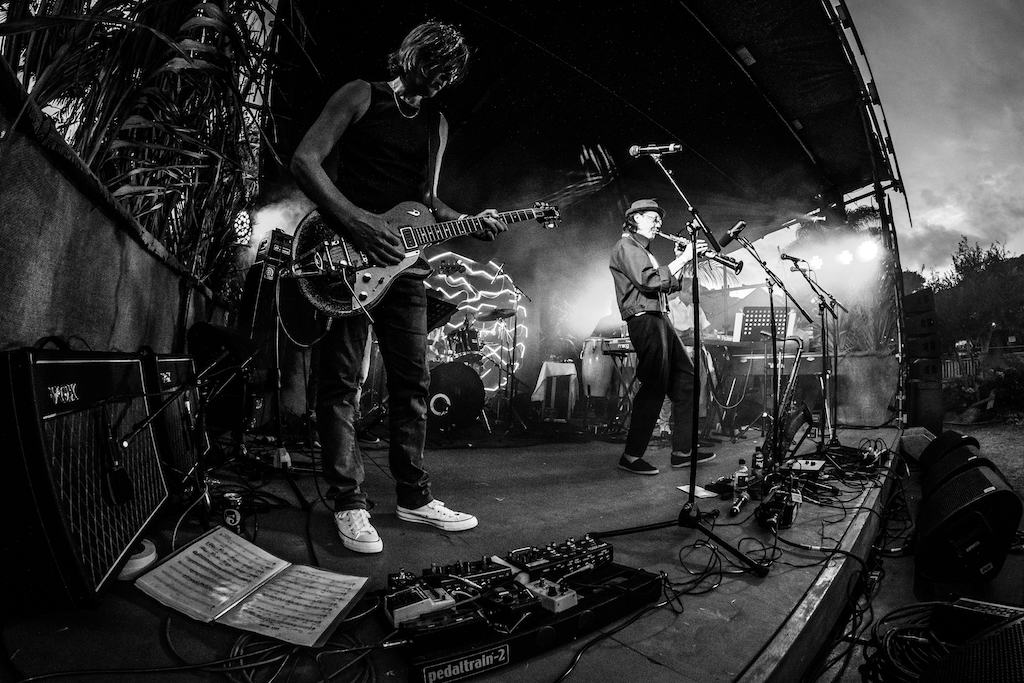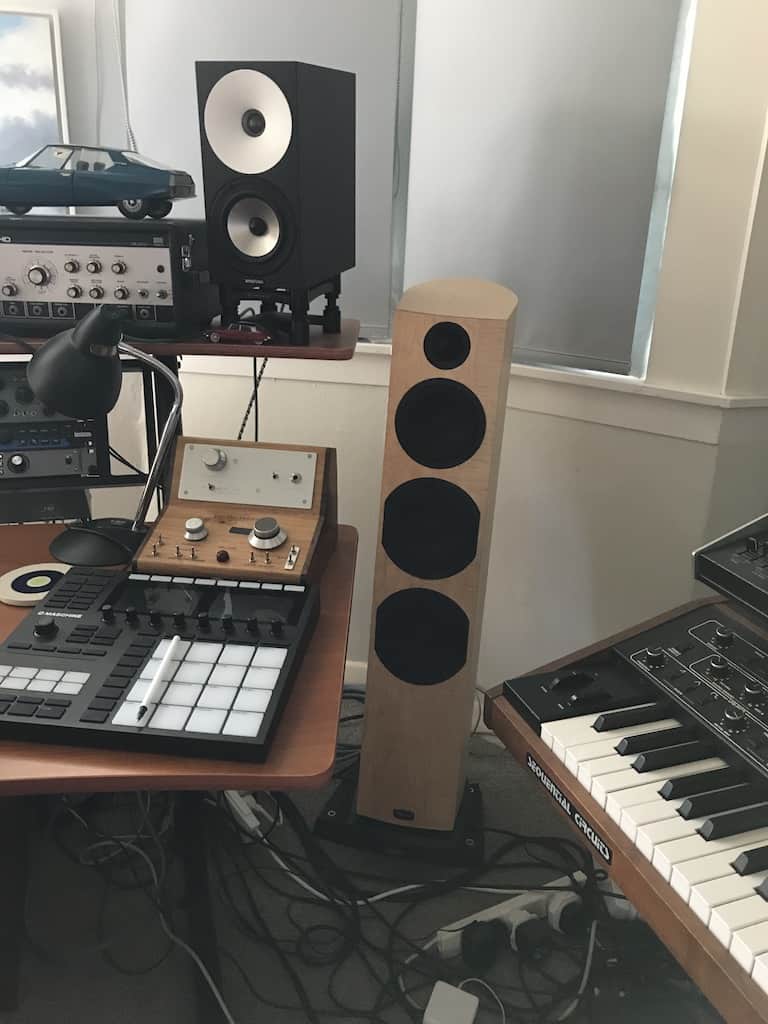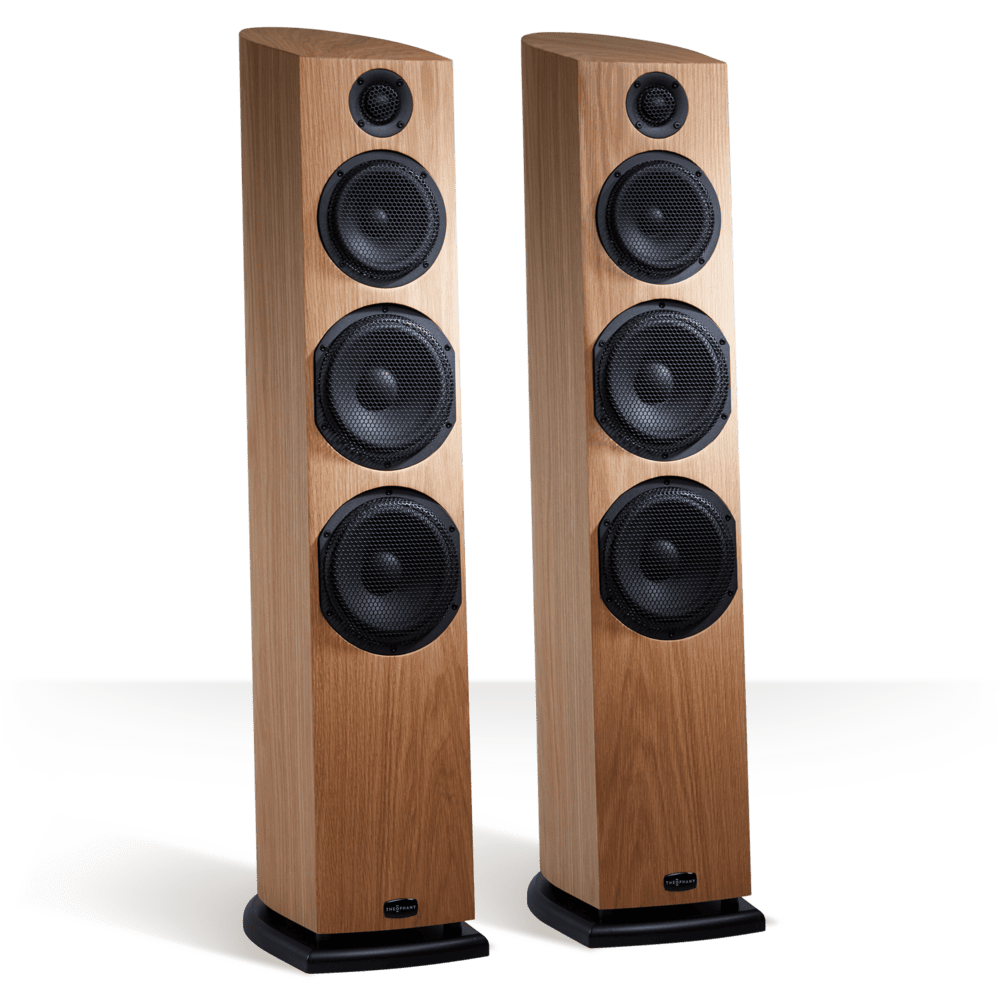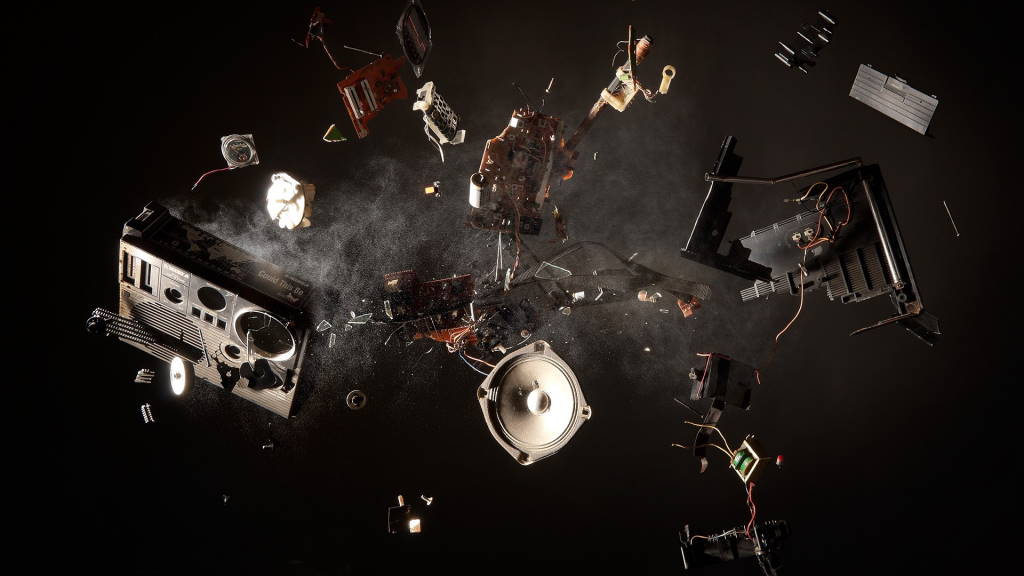NATHAN HAINES is not only a legendary Kiwi jazz/crossover music icon but an exacting audio connoisseur. Here, he explains his recent audio epiphany.

Theophany owners are in a club. It’s an almost cult-like club of smugness – a kind of “we know something you don’t know”.
I’d heard about Theophany speakers through friends, who spoke of designer Garth Murray with a kind of awed reverence, and when it came to describing his speakers, those same folks would usually say, “well, come and have a listen.”
 If you peruse TradeMe you’ll very rarely find any Theophany speakers for sale secondhand, which suggests that Theophany owners tend to hold on to their speakers for life. The other option is that Garth will take them off your hands as a trade in on a newer model, and he will find a home for your old speakers through his extensive database of Theophany owners. This in itself is highly unusual, but the further you delve into the story of Theophany, the unusual and the exceptional soon become part of the story of what Theophany as a brand is all about.
If you peruse TradeMe you’ll very rarely find any Theophany speakers for sale secondhand, which suggests that Theophany owners tend to hold on to their speakers for life. The other option is that Garth will take them off your hands as a trade in on a newer model, and he will find a home for your old speakers through his extensive database of Theophany owners. This in itself is highly unusual, but the further you delve into the story of Theophany, the unusual and the exceptional soon become part of the story of what Theophany as a brand is all about.
My curiosity got the better of me, and I organised a visit to Garth’s factory in Christchurch last year. You can read about my visit and my first impressions here.
At the end of that article, I stated that I’d ordered a pair of the Pneuma model as up to that point I hadn’t heard a speaker like them – anywhere. But by the time of writing this article, I’d had a good month or so to live and work with them.
Would you like to support our mission to bring intelligence, insight and great writing to entertainment journalism? Help to pay for the coffee that keeps our brains working and fingers typing just for you. Witchdoctor, entertainment for grownups. Your one-off (or monthly) $5 or $10 donation will support Witchdoctor.co.nz. and help us keep producing quality content. It’s really easy to donate, just click the ‘Become a supporter’ button below.
First off a caveat of sorts – I bought the Theophany Pneuma’s as studio monitors. Now I’ve got that out of the way I’ll tell you about why I bought these remarkable speakers for that purpose.
Studio monitors are designed to give the recording or mixing engineer the truest representation of what is happening in the studio. Any decisions made while mixing an album will end up as part of the finished product – that is the album you and hopefully, a lot of others will be enjoying at home.
The recording and mixdown engineer’s job is broken down into two categories, tracking and mixing. Tracking is the term for when you are recording live instruments in real-time, be it vocals, drums, individual instruments or a full large scale ensemble. Mixing is when you take these elements from either a tape recorder or these days more likely a DAW (digital audio workstation) and you sculpt these sounds into something listenable with eq, compression and other artefacts available to the engineer’s needs and wants.

It’s been said many times in the audiophile world, that as a listener of music, being as close to possible to what would have been heard at mixdown straight from the master tape (or DAW) in the studio is the closest to how it should be heard.
This truism has informed me in my decades’-long search for the ultimate audio nirvana. That’s why I prefer original vinyl pressings, often mono when listening to jazz, with a mono cartridge (currently a Miyajima Zero) on a Garrard 401 turntable through a valve integrated Sonic Frontiers SFC-1 via a Perreaux phono stage. For digital, I use a Bluesound Node 1 to sort out my streaming, with the variety of DACs I have available.
“The Theophany Pneuma name means “spirit, a breath of wind”, and being a player of wind instruments for over 40 years this hit a chord with me.”
But for me personally, this all depends on what has been uploaded to my streaming provider. Hence my decision to go for original pressings when available, as these pressings are as close to the original master tapes as possible, with proven provenance.
The test of course is in the listening. When I A/B a clean 1959 original mono pressing of the Miles Davis masterpiece Kind Of Blue to what has been uploaded to Tidal, there’s a huge difference not just in sound, but the presentation, eq, compression and overall soundstage. Without going into the in’s and out’s of digital versus analogue (which is a huge discussion with passionate adherents on both sides) if we go back to the ethos of experiencing what is closest to the master tape or master recording, then naturally it should follow that the speakers are the last piece of encoding equipment in the chain.

As I have worked in recording studios my whole life I think I am qualified to speak about hearing a master recording straight from the master tapes on studio monitors. Like almost every musician I know I would love to have a beautiful Ampex 300 valve tape recorder at home (like the one I used to record my album The Poet’s Embrace – a straight to two-track recording with no overdubs or mixing just like it was done back in the 1960s). I have many many times almost bought a Revox B77 for home listening. There is nothing like the ‘sound’ of tape, the gentle compression and softening of transients that have become how almost all of us associate with the sound of a great record. It’s no surprise that even today many if not most hit records still have tape somewhere in the chain, sometimes at the end, or best when tracking, where it imparts that classic flavour and ‘finish’.
“My first impressions of the Pneuma’s at Garth’s workshop in Christchurch were of the incredible accuracy.”
However, for my home listening and my own recording studio, I have to do without tape and instead rely on digital plug-in emulations of tape, or hardware tape simulators, which do a great job. When I work in a larger studio I always use tape, and I’ve also been known to hire a tape machine into the studio I’m working in. These are not like your average home consumer tape machines, rather they are behemoths that take two people to lift them, with tape costing many thousands of dollars, and the ability to be able to record up to 24 instruments at the same time. Multi-track recording via tape machines radically changed the face of music in the late 1960s and also ushered in the era of true stereo recordings, but that’s another discussion for another article.
From a very early age, I was always curious as to which gear was being used in recording studios on which records, along with which instruments people played – A Fender Jazz bass for Jaco Pastorious, a Selmer Mk 6 tenor for John Coltrane, or an ARP 2600 or Oberheim synthesiser for Joe Zawinul from Weather Report. That curiosity eventually lead onto how those recording and mixdown engineers heard what they heard. It turns out you’ll find a familiar list of names with a quick Google search – Altec and Tannoy Monitor Golds at Abbey Road in the 1960s and 70s, Altec and JBL in the big US studios and the ever-present Yamaha NS-10’s and Auratone as near-field monitors.

Having worked on Tannoy Monitor Golds (incredible), Yamaha NS-1000’s (amazing) and having owned a pair of matched NS-10’s for many years, I know that studio monitors all do one thing – and that thing is let you know what’s going on at the source.
When you mix a record, you need to make decisions based on what you’re hearing that will ultimately end up on the finished master. The balance between the instruments, what your ears perceive to be louder or softer, what is forward in the mix, and what drives the track along rhythmically are some of those decisions. A great mixdown engineer can make well-recorded and played music sound even greater, and it’s a true art of the highest order.
For my home listening set-up, I love my Spendor SP-1’s as I can listen to them all day (and all night) long without any fatigue. They are lovely at reproducing acoustic music, and voices, in particular, are incredibly lifelike. It’s no surprise this design was born out of original BBC monitor designs, and having owned the classic Rogers LS-3/5A near-field monitors (also a BBC design), there has always been a correlation between studio monitors and home listening. Or rather for those in pursuit of speakers that reproduce music as it was intended to be heard, professional monitors are a way to get closer to the music.
“I was enveloped by a tight, warm blanket of bass emanating from the Pneuma’s right down to 34 Hz – no need for a sub here”
As much as I love my Spendors I wouldn’t use them in the studio. My most recent large studio monitors were a pair of 1970s Tannoy Cheviots in original cabinets, paired with a pair of Amphion 15’s as my near-field monitors. These are excellent and have now become common in many recording studios. The Tannoys gave me bass when I needed it and were a great, fun speaker for listening to modern dance music or hip-hop.
I was pretty happy with the Tannoys. That is, until last year when I heard the Theophany Pneuma. In my review I said I was amazed at how these speakers sounded so precise – the imaging was incredible and the reproduction of bass was in a new ballpark (for me anyway).

So I took the bold leap of faith and sold the Tannoys to a friend to fund the purchase of a new, made to order pair of Pneuma’s from Garth at Theophany.
The Theophany Pneuma name means “spirit, a breath of wind”, and being a player of wind instruments for over 40 years this hit a chord with me.
After ordering a natural maple finish (admittedly lighter than I had envisioned but still very nice), the Pneuma’s arrived after a couple of months via courier in two large cardboard boxes. Wrapped in plastic and fitting snugly into polystyrene inserts, the Pneuma’s took a good 10 minutes to prise out of their boxes.
Weighing in at over 10kgs each, these are no lightweights and it took some manoeuvring to get them into place alongside my studio desk furniture and into the monitoring sweet spot.
“As I pulled back my chair and got into the sweet spot, the imaging was incredible.”
The Pneuma’s are designed to be listened to from a good few meters away, not as near-field monitors. My current set-up is not ideal for these speakers, but I simply pull the chair back from the desk and get the full range of the speakers from a position further back than where I normally work from. In my purpose-built recording studio which is nearing completion after several months of work, the Pneuma’s will be situated further back from my desk on stands approximately 30 cms high so the tweeters are more at ear level.
I have paired the Pneuma’s with an early re-capped Perreaux PMF 1150B power amplifier. At 100W per channel, Garth said this should be plenty of power to get the best from the speakers. I asked him about efficiency and this is what he came back with:
“I have to admit to playing with the efficiency. My goal has been to keep the speaker flat with regard to response rather than the most efficient. The Pneuma starts off at around 91 but I do bring it down to around 89db. I have a problem with a lot of companies who promote very high efficiency but efficiency does not measure anything but white noise or overall peaks so you could have one little peak from the tweeter at say 93 but the rest of the speaker could be at 87 and you can still call it + or – 3db. This sounds harsh or scratchy and not what I am after. So we try to balance the speakers as best as we possibly can to have all frequencies as close to the maximum efficiency as possible.”
A typical detailed response in my dealings with Garth, and it goes some way to explain the smoothness and overall coherence of the Pneuma.

So, are Theophany Pneuma’s studio monitors? Or are they just great speakers?
Well, having lived with them for a month, I’d say both.
My first impressions of the Pneuma’s at Garth’s workshop in Christchurch were of the incredible accuracy – once again, that’s something which engineers are looking for in the studio.
I decided to test them straight out of the box with a recent song put together by some very good friends of mine in the UK. Mike Patto, who produced my albums The Poet’s Embrace, Vermillion Skies and most recently 5 A Day (recorded and mixed in Mike’s home studio in the UK) shares mixdown and production duties on this track. When he sent it to me before I had the Pneuma’s, I was very enamoured by the bass. So it was a natural choice to hear what these speakers could do. I’ve provided a Spotify link here for the review but I use Tidal at home.
Featuring US rapper Speech who came to prominence in the 1990s as a member of the band Arrested Development, this track is a soulful blend of what I love about modern dance music – it’s got a great arrangement and enough harmony and chord complexity to satisfy the jazz musician in me, but it also kicks on the dance floor in a club.
First off, I was enveloped by a tight, warm blanket of bass emanating from the Pneuma’s right down to 34 Hz – no need for a sub here! The mids were gorgeous and the highs pristine. I’d never heard this track sound so good. As I pulled back my chair and got into the sweet spot, the imaging was incredible. I could hear (and almost ‘see’) the separation between the instruments. Everything sounded ‘right’. I didn’t want to change a thing, and listened to the whole six-plus minutes of the extended dancefloor mix in rapt silence, nodding my head and in awe of the mixdown. This brings me to an important point. I never felt like I was listening to a pair of speakers. I was just listening to the music, as it was intended to be heard. And knowing my friend Mike Patto so well and how he works and how he mixes, these Theophany Pneuma’s were doing the perfect job of not getting in the way.
After the Reel People track I thought I’d dial up something I’d always enjoyed on the Tannoys: US producer Kaytranada’s debut album was a firm favourite when it dropped in 2018, and this track was one of my go-to’s when I wanted to check how my own mixes were standing up.
‘Bullets’ featuring Little Dragon is a track with some serious sub-bass, peppered with some fantastic vocals and Kaytranada’s trademark side chain compression technique which imparts a hypnotic pulsing groove that has become very ‘of the now’ in dance music and has found its way into pop music. Like a lot of initially underground music, it soon became mainstream and picked up on by pop producers. Through the Pneuma’s, ‘Bullets’ was sounding as rich, gorgeous and danceable as it had on the Tannoys but with a whole new set of parameters due to Garth’s modern speaker design. The highs from this speaker are never harsh; rather, they are part of the overall sonic spectrum, and blend seamlessly into the mids and bass, while imparting a sonic sheen that is never too strident or cloying. The Pneuma’s also import a compactness to the sound – it’s like all the frequencies are working together as a whole, not against each other.
So far so good – and so far pretty much only digital recordings. But what about some acoustic music from the golden era of recording? What about some Steely Dan? Say, ‘Babylon Sisters’ from their 7th studio album Gaucho from 1980? It’s a known fact that this was a problematic album for Steely Dan, with the album budget being blown out of the water by having 42 (yes 42!) studio musicians appearing across its seven tracks – and it took over a year in the studio to record, with some tracks being mistakenly wiped by a studio lackey that has surely never lived down the fact he erased a finished master tape. Did he ever work again? I think not.
“I could hear (and almost ‘see’) the separation between the instruments. Everything sounded ‘right’.”
It was the Dan’s last album before a 20-year hiatus, with swirling rumours of drug addiction, burnout and in-fighting signalling it was time to take a break. However, as an album it’s a piece of sonic perfection – it’s got high art written all over it. I played an original vinyl pressing through my vinyl studio set-up to test the Pneuma’s – a high-end Sony DD 2250 direct drive turntable from the 1970s with a Grace F14 cartridge, through a Croft valve pre-amp with phono stage. I use this combination to rip my vinyl for listening in digital or to use when DJ’ing when I don’t want to bring records, or risk using a dodgy turntable set-up which – as it turns out – is more often than not.
From drummer Bernard Purdie’s introduction fill to the first note’s of Donald Fagen’s Fender Rhodes, the Pneuma’s delivered – and then some. By the time the backing vocals came in, I was in heaven. I don’t think I’d ever heard this track sound so good from the vinyl. Once again these speakers just delivered the music as it was intended to be heard. It was all there in its sonic glory, with every detail revealed. I could really hear the hundreds of hours spent on the tracking and the mixing. Steely Dan were known to be perfectionists in the studio, and with speakers this revealing, it’s like I was there at the mixing desk listening to the masters.
“I never felt like I was listening to a pair of speakers.I was just listening to the music, as it was intended to be heard.”
For further reference, I put on something from my own vinyl releases – ‘Celestial You’ from my album Vermillion Skies. This was recorded at York Street studios via a vintage Neve desk with vintage microphones and we were all playing at the same time. As I dropped the track on to the turntable, I was startled at hearing it warts and all – you could hear my fingers on the sax keys, my breath through the instrument, and every tiny nuance of the drums and the acoustic bass came out of the speakers at me in full force. It was almost too revealing, and I took it off the turntable after a minute or so. Not because it sounded bad, but because it took me straight back to the studio on the very day I recorded it, and I was drifting off, thinking more about the note choices I had made instead of the music.
So it was back to the music and the Pneuma’s. I decided to test something on Spotify – which is not my streaming provider of choice, but as I’m asked to do Spotify playlists professionally for brands and clients, I wanted to see how the Pneuma’s performed.
I kicked off with Hungarian-born guitarist Gabor Szabo, who recently garnered a whole legion of new fans via his inclusion on the wildly popular The Queen’s Gambit on Netflix. ‘Somewhere I Belong’ is from his excellent 1969 album (the year being the actual name of the album). I had owned this for several years on vinyl, so when the opening guitar riff appeared on The Queens Gambit in a scene, I couldn’t believe my ears! Gabor Szabo is not exactly a household name, even in jazz circles, so I applauded the music sync team for using this piece of music and introducing him to a whole new audience. While I enjoyed listening to the track through the Pneuma’s, I was instantly let down by the inferior sound of Spotify Premium (if you can call it that).
That’s the thing about these speakers – you hear what you put in, that’s for sure.
Over the following month, I’ve been using the Pneuma’s as my second set of larger studio monitors, switching between the Amphion 15’s when I’m mixing music. I’ve set the gain stages the same, and when I switch the larger Pneuma’s in after working on the smaller Amphion’s for some time, the flood of bass is what’s most welcome. But it’s more than just bass. There’s a wonderful sense of rightness in the mids, too, not to mention those gorgeous tops. I can make those mix decision on these speakers just as I would on my other professional studio monitors.
My only regret is that I didn’t order the larger (and more expensive) Airo!
I may be contacting Garth in the future for a trade-in. Theophany are that good.
* The Pneuma loudspeaker is available from Theophany – www.theophanyloudspeakers.com















